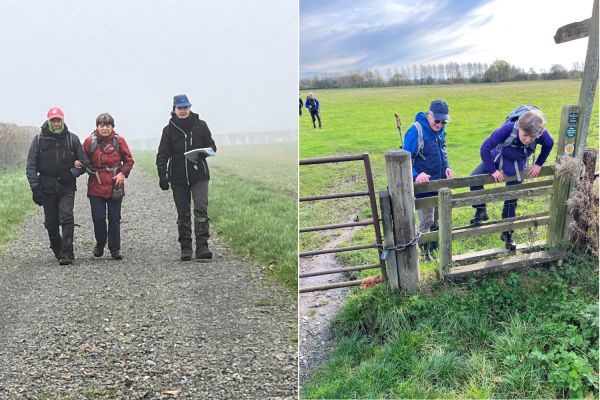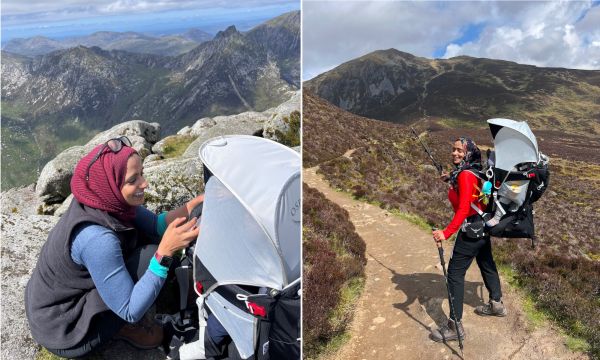Our local paths
How paths are part of our everyday lives

Our path network is a national treasure. It’s our gateway to the outdoors. Spreading out from towns, cities and villages, Britain’s paths connect us to one another, to nature and have a huge impact on our health and wellbeing.
Here five people share with us their experiences of using their local paths, and the important role they play in their lives.

Tom
When you have a child in a pram, you get a real sense of barriers to walking and a bit of empathy for people that have ability issues. Not too far from where I live there is a new housing estate that has been being gradually built over the past 10 years. The original vision for the estate said there would be good cycle and walking connections to the surrounding areas.
But, what could have been direct walking access is actually a flight of about 30 steps which means it isn’t accessible for so many people. I think there was supposed to be another more accessible route but that was never built. And when you get on to the road, the pavement is really narrow and falling apart so it’s really difficult to use with a pram.
If I want to go walking in the countryside there are a lot of stiles and gates that aren't accessible. So that makes it quite difficult to go walking with a pram.
Arron
I've been a member of the Ramblers since I was 21. I had just finished university and had been unemployed for four months. I embarked on my first Ramblers walk with the help of a car share from a kind group member. I realised I’d found a hobby that was inexpensive and that is great for people who are unemployed or people who earn a lower income.
Walking provides me with an escape: a physical escape from Liverpool’s urban environment; a mental escape from any problems I’m having. When out walking I can just focus on being in the here and now and being there for myself. Even seven years into to rambling, I'm still finding new places that I've never been to.

Dianne
I am Australian and moved to the UK after I met my husband. I spent my career in Australia’s National Parks, as a ranger and a conservation officer, so I know the benefits of access to green space. Public rights of way are unique to Britain, and they’re priceless. Living in England, even in London, I saw more people regularly enjoying the outdoors than anywhere else I’ve been.
I learned that the Ramblers formed the core lobby group to maintain and expand rights of way. That’s another reason I’m a huge supporter. I urge all ramblers to keep fighting for them and bring in the next generation, because they’re a tremendous public asset.
Pearl
I live in Newark with my partner and our two Yorkshire Terriers called Moose and Mash. The dog walk I do in the morning is directly from our front door and has the perfect variety of scenery and plenty to keep the dogs interested. The path is a tarmacked shared-use path for cyclists and walkers. It is has a canopy of leaves and foliage and lots of wildflowers, and passes a lake where there are always fishermen. It's stunning and my morning walk is my favourite part of the day. It’s an hour of peace and not having to think about anything, do anything or worry about anything.
The walk we do in the in the evening is around the Queen’s Sconce in Newark. There’s a new path in the park with parts that are ridiculously steep. I think that when winter comes it’s going to be really dangerous. It’s in the wooded area so in the rain it gets quite muddy and with fallen leaves I can see it becoming really slippery. There are lots of elderly people that walk in the park and I think they would really struggle with it. One of my best friends is disabled and uses a wheelchair so I am used to pushing her wheelchair and have experience of the difficulties that a disabled person can experience. So as soon as I saw the new path, it just instantly made me think how tricky it would be to get someone in a wheelchair up and down it. And that’s such a shame as it would restrict my friend from accessing one of the most beautiful parts of that walk.

Ian
I am 39 years old and was born totally blind. For a blind person, paths are quite important because we navigate using a cane or guide dog, and we rely on using landmarks. If there were an open grassy space without a path to follow, it would be extremely difficult to know where I was heading. Also walking canes don’t move well on grass. They are much more suited to paths. Although on country paths I tend not to use my cane because there can be gravel and other things in the way. I find my feet do a job better of sensing the ground.
The ideal path is as flat and as even as possible. I’m pretty fit and I've got good balance, but some blind people would be less confident in their footing. The best material is tarmac because it has less hazards and more grip than gravel. Overhanging bushes are a problem because I can’t see them and the cane can't detect them.

Walking is about more than what you can see
Ramblers member Marika has been blind since childhood, but that hasn’t stopped her from enjoying walking.

Walking when pregnant and as a new mum
Zahrah Mahmood, president of Ramblers Scotland, shares her experiences of walking whilst pregnant and as a new mum.

Passing on the love of walking through the generations
Daniel’s grandparents inspired in him a love of walking which he is in turn passing on to his young daughter.